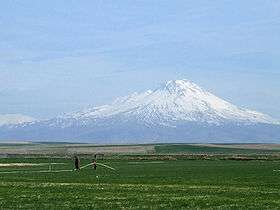Mount Hasan
| Mount Hasan | |
|---|---|
 | |
| Highest point | |
| Elevation | 3,268 m (10,722 ft) [1] |
| Prominence | 1,922 m (6,306 ft) [1] |
| Listing | Ultra |
| Coordinates | 38°07′39″N 34°10′00″E / 38.12750°N 34.16667°ECoordinates: 38°07′39″N 34°10′00″E / 38.12750°N 34.16667°E [1] |
| Geography | |
 Mount Hasan Turkey | |
| Location | Aksaray Province, Turkey |
| Geology | |
| Mountain type | Stratovolcano |
| Last eruption | 6200 BC |
Mount Hasan (Turkish: Hasan Dağı) is an inactive stratovolcano in Aksaray province, Turkey. With an elevation of 3,268 m (10,722 ft),[2] it ranks as the second highest mountain of central Anatolia. A caldera 4-5 kilometres wide formed near the current summit around 7500 BC, in an eruption recorded in Neolithic paintings.[3]
The ancient settlement of Çatalhöyük collected obsidian from the area of Hasan Dağ, which they probably traded with other settlements for luxury goods. Obsidian mirrors and flakes have also been found. The importance of Hasan Dağ to the people of Çatalhöyük may be shown by a wall painting, sometimes called the "first landscape" by art historians, which some believe is a depiction of Hasan Dağ towering over the settlement's houses.
It was the second mountain from the south in the Byzantine beacon system used to warn the Byzantine capital of Constantinople of incursions during the Arab–Byzantine wars.
Approximately a six hours' walk is required to climb to the top of the mountain from the highest point accessible by car. The summit offers a fabulous view over the central Anatolian plateau, including distant Cappadocia.
See also
References
- 1 2 3 "Turkey: 23 Mountain Summits with Prominence of 1,500 meters or greater". Peaklist.org. Retrieved 2014-05-25.
- ↑ "Hasan Dagi, Turkey". Peakbagger.com. Retrieved 2014-05-25.
- ↑ "Çatalhöyük ‘Map’ Mural May Depict Volcanic Eruption 8,900 Years Ago | Archaeology | Sci-News.com". www.sci-news.com. Retrieved 2016-04-13.
External links
- "Hasan Dagi". Global Volcanism Program. Smithsonian Institution.
- (in Turkish) Niğde
| Wikimedia Commons has media related to Mount Hasan. |